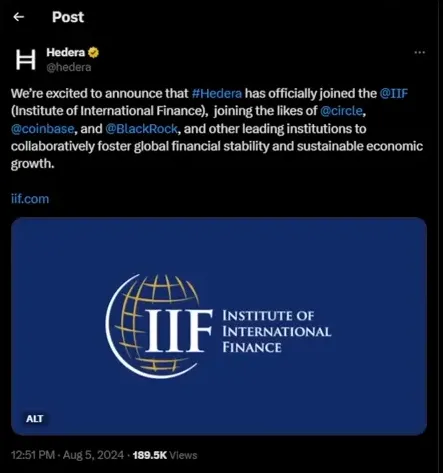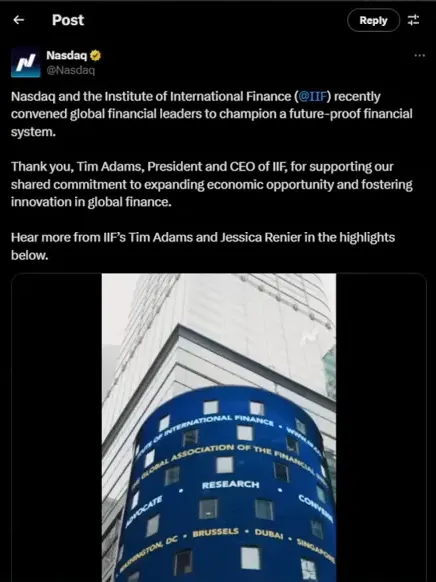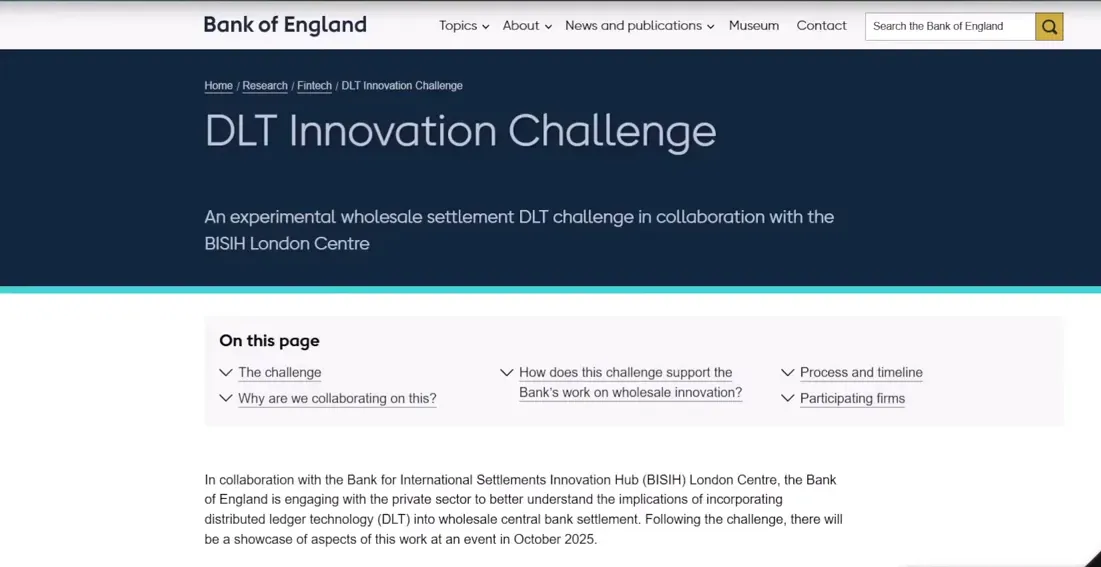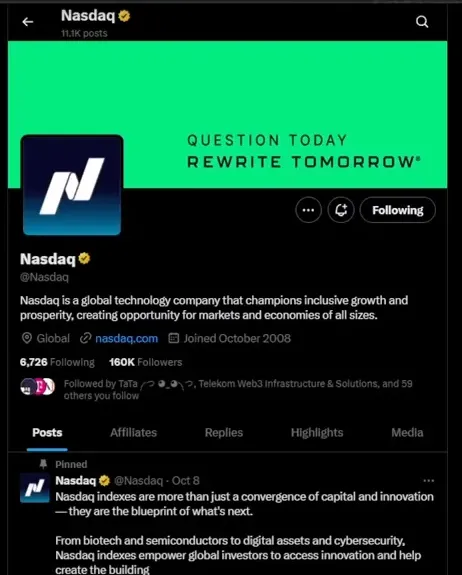Last Updated: October 29, 2025
I have been tracking Hedera closely and the signal I am watching most closely is institutional adoption. When major institutions start to pick a distributed ledger technology, it changes the game for everything from tokenization to stablecoin payments to the potential for 24-7 trading. If you care about HBAR Price Prediction, you cannot ignore the institutional lanes that Hedera is moving through right now.

Table of Contents
- Outline
- Why the IIF membership matters
- NASDAq, the IIF, and a bell that signals integration
- Project Agora and the BIS: bridging public and private workstreams
- Bank of England and the DLT Innovation Challenge: Hedera is being tested
- What makes Hedera attractive to institutions
- Tokenization and stablecoins: where the rubber meets the road
- Practical adoption pathways: pilots, limited production, and scaled use
- HBAR Price Prediction: scenarios and drivers
- What to watch next: catalysts that will move price and adoption
- How traders and long-term holders can position
- Risks and caveats
- Conclusion: Why this matters and what to do now
- What does Hedera joining the IIF mean for institutional adoption?
- How does the NASDAQ and IIF engagement affect HBAR Price Prediction?
- What is Project Agora and why is it relevant?
- Can central bank pilots actually influence HBAR token demand?
- How should traders use institutional news in an HBAR Price Prediction strategy?
- What are the major risks to be aware of?
- When might we see a meaningful price impact from institutional adoption?
Outline
- Why the IIF membership matters for institutional credibility
- What the NASDAQ ring ceremony and IIF delegation mean
- Project Agora and BIS: the convergence of public and private sector
- Bank of England DLT Innovation Challenge and Hedera’s role
- Technical strengths that make Hedera a natural institutional choice
- Tokenization, stablecoins, and real-world use cases
- Trading context, opportunities, and how crypto trading signal can help
- HBAR Price Prediction scenarios and key variables
- Risks and timelines
- Frequently asked questions
Why the IIF membership matters
One of the most underappreciated developments for Hedera was its acceptance into the Institute of International Finance. The IIF represents a massive roll call of the financial industry: over 400 members across 60 plus countries, including commercial and investment banks, asset managers, exchanges, sovereign wealth funds, and central banks. That is the sort of institutional imprimatur that moves conversations from speculative forums to boardrooms and regulatory working groups.
From an HBAR Price Prediction perspective, membership in the IIF changes the narrative. Instead of being a fringe ledger discussed only in crypto circles, Hedera now shares a table with players like BlackRock, Fidelity, Coinbase, and major global banks. This matters because institutional participation tends to unlock use cases that generate real economic activity on a network: custodial issuance, regulated tokenized securities, institutional stablecoin rails, and settlement integrations with legacy infrastructure. Those activities create real demand for network services and, depending on token economics and custody, can influence price dynamics for HBAR.
NASDAq, the IIF, and a bell that signals integration
When the IIF convened with NASDAQ for a public event focused on what they called a “future proof financial system,” Hedera’s presence was more than symbolic. A Hedera policy officer joining the IIF delegation at NASDAQ’s ring the bell ceremony is a real-world sign of the growing intersection between traditional finance and distributed ledger technology. NASDAQ is a key market infrastructure firm that has been publicly discussing blockchain-enabled enhancements like longer trading windows and tokenized securities.
For those doing an HBAR Price Prediction, this is a catalyst to watch. NASDAQ exploring 24-5 and eventually 24-7 trading is one of many market structure initiatives that could create demand for programmable, low-latency, and secure ledger systems. Hedera’s performance characteristics and governance model position it as a candidate for these kinds of market structure experiments. As market infrastructure talks turn into pilots and production integrations, token flow and service usage on a network like Hedera can increase meaningfully.

Project Agora and the BIS: bridging public and private workstreams
Project Agora, launched by the Bank for International Settlements, was a call for participation that intentionally blended public sector central banks with private sector participants to explore new architectures for cross-border payments and digital money. The BIS brought in seven central banks and partnered with the IIF to create a bridge to private sector innovation. This convergence is significant: it is not a speculative conversation any longer. It is a collaborative design exercise with senior bankers and policy leaders providing real requirements.
Hedera being in close orbit of Project Agora-related work is meaningful for two reasons. First, the public sector group needs ledger technology that can demonstrate operational resilience, auditability, and a robust governance framework. Second, the private sector group needs a platform that can interoperate with existing market players and support tokenization and programmable money. Hedera’s hybrid approach — a governed public distributed ledger with enterprise-ready APIs and tokenization services — checks many boxes. For HBAR Price Prediction, the implication is clear: participation in these cross-sector initiatives often precedes pilot activity, which in turn can produce demand signals for network tokens and services.
Bank of England and the DLT Innovation Challenge: Hedera is being tested
The Bank of England, in partnership with the BIS, launched a DLT Innovation Challenge to explore how central bank money could be transacted on external programmable ledgers. Hedera’s inclusion in that POC-style environment is a practical test. It means Hedera is being evaluated not as a theoretical tech stack but as a potential conduit for central bank money interactions with private sector systems.
Why does this matter for HBAR Price Prediction? Because central bank involvement tends to bring clarity to regulatory and operational pathways. If a central bank pilot demonstrates that programmable ledgers can safely and efficiently interface with central bank money, commercial banks and financial market infrastructures may move from R&D to limited deployments. Each stage of commercialization increases real transaction volumes and service needs on the ledger. Whether that translates directly to HBAR demand depends on future token utility, gas models, and custody arrangements, but the pathway is now more visible.

What makes Hedera attractive to institutions
There are technical and governance attributes that make Hedera stand out among distributed ledger projects. These are not just marketing claims. The combination of these characteristics explains why major financial players and regulatory bodies are willing to engage with Hedera at the table.
- Governance council model: Hedera’s council is composed of multinational organizations from different sectors. The council approach gives institutions confidence that the network is managed by a diverse set of corporate actors rather than a single foundation or anonymous validators. Governance credibility matters when you are moving assets worth billions or when a central bank wants to experiment.
- Performance and finality: Low-latency consensus and deterministic finality matter for market infrastructure. Hedera’s consensus algorithm provides fast transactions and finality that is attractive when you need to settle trades, custody, or tokenized securities.
- Tokenization toolset: Native tokenization features simplify issuance, compliance flags, and lifecycle management. For real-world asset tokenization, having native constructs is a differentiator.
- Enterprise-grade APIs and interoperability: Hedera offers standard API patterns and libraries that ease integration with existing systems. This is essential when banks and exchanges want to pilot without rearchitecting their stacks.
- Regulatory engagement: Participation in groups like the IIF, BIS projects, and central bank challenges signals active dialogue with regulators, which reduces implementation friction.
These attributes are why I keep returning to the single idea: institutions are not just kicking Hedera’s tires. They are actively inviting Hedera into serious collaborative processes. That is one of the clearest bullish signals for anyone doing an HBAR Price Prediction over multi-year horizons.
Tokenization and stablecoins: where the rubber meets the road
Tokenization is not a niche concept anymore. Securities, debt instruments, real estate shares, loyalty points, and stablecoins are all being rethought with tokens in mind. When the IIF and NASDAQ discuss tokenization publicly, they are outlining the future plumbing for how value will move. Hedera’s native tokenization capabilities are well placed to capture a share of that activity.
Stablecoins are a particularly interesting use case. Institutional stablecoin usage is already growing for custody and settlement purposes. A stablecoin that can be transacted on a programmable ledger that is fast, auditable, and governed by credible actors becomes an attractive settlement layer for institutional players.
From a trading perspective, tokenization and stablecoins expand the tradable universe and unlock new liquidity pools. If banks and exchanges use Hedera for tokenized securities or stablecoin settlement, that will make the network a hub for value movement. For traders aiming to capitalize on evolving liquidity, a credible crypto trading signal can help identify the most promising entry and exit points as these institutional integrations progress. Subscribing to a well-informed crypto trading signal service can provide timely, risk-conscious signals that align with on-chain adoption catalysts like pilot commencements or production rollouts.
Practical adoption pathways: pilots, limited production, and scaled use
Institutional adoption rarely jumps from discussion to full-scale deployment overnight. The typical progression is:
- Pilot and proof of concept under tightly controlled conditions
- Regulatory assessment and compliance testing
- Limited production deployments for narrow use cases
- Wider rollouts as operational experience accumulates
Hedera is currently visible in steps one and two with projects involving central banks, the IIF, the BIS, and market infrastructure firms. That visibility increases the probability of steps three and four over multi-year timeframes. Each stage introduces new flows of demand — for tokenization services, transaction throughput, and enterprise-grade tooling — all of which matter when building an HBAR Price Prediction model.
HBAR Price Prediction: scenarios and drivers
My HBAR Price Prediction framework depends on three categories of drivers: fundamental adoption, token utility and economics, and macro liquidity dynamics. Below are scenario-based projections that illustrate how institutional activity could impact price under different assumptions.
Scenario 1: Baseline adoption (slow, steady)
Assumptions: Hedera continues to participate in industry working groups and conducts periodic pilots. A few tokenization pilots become limited production deployments. Demand for network services grows modestly. No major regulatory barriers emerge.
Implication for HBAR Price Prediction: Moderate increase in network usage results in steady demand for HBAR for transaction fees and service utility. Price appreciation is gradual as adoption widens but remains correlated with broader crypto market cycles.
Scenario 2: Institutional acceleration (multiple production rollouts)
Assumptions: Successful POCs with central banks and exchanges convert to limited production. Tokenized securities and stablecoin rails become active on Hedera. Several multinational institutions adopt Hedera-based workflows.
Implication for HBAR Price Prediction: Demand for Hedera services rises materially. If custody solutions convert operational usage into on-chain demand for HBAR (for fees or staking-like mechanisms where relevant), the supply-demand imbalance could produce significant upside. In this scenario, HBAR Price Prediction tilts bullish with accelerated appreciation as real economic activity drives network value.
Scenario 3: Regulatory or technical setbacks
Assumptions: Regulatory uncertainty in key jurisdictions slows adoption, or a competing ledger signs major institutional contracts. Technical limitations or governance disputes reduce institutional confidence.
Implication for HBAR Price Prediction: Price pressure emerges as expectations shift. Even if long-term fundamentals remain strong, short-term sentiment could suffer, leading to volatility. Traders should watch institutional announcements and regulatory signals closely.
These scenarios are not exhaustive but serve as a framework for thinking about where HBAR could go. If you are actively trading around these developments, a crypto trading signal service can be helpful for translating institutional event risk into tactical trade ideas. The signals should be used as tools to complement fundamental views rather than substitutes for due diligence.

What to watch next: catalysts that will move price and adoption
- Official pilot outcomes from the Bank of England and BIS DLT Challenge
- Production-level announcements from NASDAQ or major exchanges using Hedera for tokenization
- New IIF working groups publishing recommendations or operational frameworks referencing Hedera
- Commercial rollouts by council members or other institutional partners that use Hedera for settlement or token issuance
- Regulatory clarity in jurisdictions that host major financial markets
Each of these items is a potential accelerant for the HBAR Price Prediction models we build. Positive outcomes at any of these touchpoints can lead to increased protocol activity and, subsequently, economic demand for token-related services.
How traders and long-term holders can position
There are two broad groups of participants who care about an HBAR Price Prediction: traders and long-term holders. Their strategies should differ based on time horizon and risk tolerance.
Traders
- Focus on event-driven opportunities: pilot completion dates, council announcements, NASDAQ or IIF publications.
- Use position sizing to manage exposure around headline events; institutional news can create spikes and retracements.
- Consider combining technical analysis with fundamental triggers. A crypto trading signal subscription can provide timely alerts tied to on-chain and off-chain catalysts to manage entry and exit points more effectively.
Long-term holders
- Assess the roadmap, governance robustness, and real-world adoption pathways.
- Monitor institutional integrations and tokenization deals that create recurring network demand.
- View current price action through the lens of multi-year secular adoption if you believe in Hedera’s institutional thesis.
Risks and caveats
No analysis is complete without acknowledging risks. Here are the primary concerns to factor into any HBAR Price Prediction:
- Regulatory uncertainty remains a major factor, especially around tokenized securities and stablecoins.
- Competing technologies could capture institutional mindshare, especially if they have stronger integration with existing market infrastructure or more favorable regulatory narratives.
- Token economics and utility design will ultimately determine how much network activity translates into token demand.
- Macroeconomic shocks and liquidity conditions across global markets will affect speculative assets, including network tokens like HBAR.
Balancing optimism about institutional adoption with these risks is essential for a realistic HBAR Price Prediction. Use objective milestones and data points to update probability assessments as the landscape evolves.
Conclusion: Why this matters and what to do now
Hedera’s proximity to the IIF, BIS initiatives, NASDAQ engagements, and central banking pilots marks a meaningful step forward. This is not just noise. It is the kind of engagement that precedes pilots and production deployments, and those deployments are what produce sustainable demand for network services.
If you are building an HBAR Price Prediction, anchor your thesis to observable institutional milestones. Track pilot outcomes, council member announcements, and regulatory working group outputs. For traders, a reliable crypto trading signal can be an effective complement to fundamentals, helping spot tactical entry and exit windows as these institutional processes unfold.
What does Hedera joining the IIF mean for institutional adoption?
It signals institutional credibility. Joining the IIF places Hedera in a forum with major banks, asset managers, and central bank interlocutors, which can accelerate pilot programs and create pathways for production use cases like tokenization and stablecoin settlement.
How does the NASDAQ and IIF engagement affect HBAR Price Prediction?
Engagements that involve market infrastructure firms like NASDAQ indicate interest in use cases such as longer trading windows and tokenized securities. If NASDAQ moves from exploration to pilots on Hedera or a Hedera-like ledger, that could materially increase network activity and positively impact HBAR demand.
What is Project Agora and why is it relevant?
Project Agora is a BIS initiative that brought together central banks and private sector participants to explore cross-border and digital money architectures. Its relevance lies in the collaborative design approach between public and private sectors. Hedera’s proximity to this work suggests it may be considered for interoperability and tokenization use cases.
Can central bank pilots actually influence HBAR token demand?
Central bank pilots influence infrastructure choices and regulatory clarity. While pilots themselves do not automatically translate into token demand, successful integrations and follow-on commercial deployments can create service demand that ultimately impacts token utility and potentially token economics.
How should traders use institutional news in an HBAR Price Prediction strategy?
Traders should use institutional news as event-based catalysts. Monitor announcement calendars, look for pilot result dates, and combine that information with technical signals. A curated crypto trading signal can provide actionable trade ideas timed to institutional milestones.
What are the major risks to be aware of?
The main risks include regulatory uncertainty, competing ledger adoption by institutions, technical or governance issues, and macroeconomic volatility. Any HBAR Price Prediction should incorporate these downside scenarios and use conservative probability-weighting for optimistic outcomes.
When might we see a meaningful price impact from institutional adoption?
Meaningful price impacts typically appear after pilots convert to limited production or commercial rollouts. That timeline can vary from months to years depending on regulatory timelines and institutional procurement cycles. Watch for production-level announcements as the strongest near-term catalysts.



